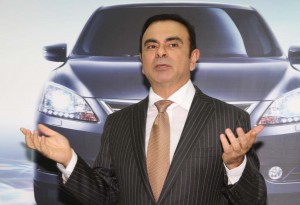
Government support for battery power and other alternatives is critical, says Nissan CEO Carlos Ghosn.
In the wake of the superstorm that swept through much of the Atlantic coast, there’s growing debate over the steps that must be taken to prevent similar disasters – with even some traditional skeptics now conceding their concerns about global warming.
For his part, Nissan CEO Carlos Ghosn believes “some kind of vision” about alternative vehicles must be included in any plans for the future.
The continued dependence on oil for most of the world’s transportation needs “cannot continue,” Ghosn declared during a speech at the Wall Street Journal CEO forum in Washington, D.C. “There are a lot of (alternative) technologies available,” he asserted.
That clearly includes battery power, something that Nissan and its French alliance partner Renault have so far invested nearly $6 billion in. Nissan’s little Leaf battery-electric vehicle was the first BEV from a major manufacturer in almost two decades when it came to market in late 2010. Between them, the two companies expect to have capacity in place to produce more than 500,000 battery cars annually by mid-decade, including a new plant in Tennessee that will produce both the Leaf and the upcoming Infiniti LE.
Nissan is not alone, however. General Motors is rapidly expanding its mix of plug-in hybrids, such as the Chevrolet Volt and Opel Ampera, as well as battery-electric vehicles – the first of which, the Chevrolet Spark, will debut at this month’s LA Auto Show.
But demand has been lagging earlier forecasts. GM barely missed its 10,000-unit target for 2011 and though sales are up sharply in 2012 it still will fall well short of a project market for 45,000 Volts in the U.S. this year. Demand for the Leaf was down 16% for the first 10 months of 2012 but jumped 86% in October, to 1,579. Nissan officials are hoping that sales will increase even more sharply when the factory in Smyrna gets underway.
A variety of other makers is getting into the alternative power market, including Toyota and Honda, the latter planning to introduce the plug-in Honda Accord PHEV at the LA Auto Show. Ford, meanwhile, will unveil its first plug-in hybrid in Los Angeles, as well. But sales results continue to generally lag demand.
And many industry leaders – as well as outside analysts – contend that it will take both rising gas prices and increased government support to get the market moving at a brisk pace.
The Obama Administration, however, failed to generate the necessary support when it proposed increasing the current maximum tax credit for qualifying alternate power vehicles to $10,000 from the current $7,500.
Proponents contend that in the wake of Superstorm Sandy – which many blame on global warming – it could be the right time to reintroduce that proposal and possibly other measures backing alternative automotive propulsion technology.
“There must be some kind of vision, policy about energy,” declared Ghosn.
But skeptics contend that any hope of boosting government backing will be stymied by the nation’s financial crisis. With lawmakers struggling to avoid the so-called “Fiscal Cliff,” cutting spending, rather than increasing government funding, could be the order of the day – and many more to follow.
For his part, Ghosn continues to say he expects to sell a cumulative 1.5 million electric vehicles at Nissan and Renault by 2015. And he is looking to see sales reach an annual pace of 500,000 before the decade is out.
But in an interview with Automotive News, the CEO warned that with other nations, such as Germany, China and Japan clearly recognize the need to cut oil consumption and are supporting that with battery car subsidies,
“No matter what, the United States is going to have to embrace electric cars in a way that is more sustainable,” he said.
